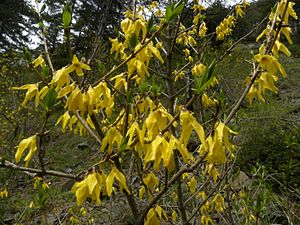European forsythia
| European forsythia | ||||||||||||
|---|---|---|---|---|---|---|---|---|---|---|---|---|

European forsythia ( Forsythia europaea ) in its natural habitat in Albania |
||||||||||||
| Systematics | ||||||||||||
|
||||||||||||
| Scientific name | ||||||||||||
| Forsythia europaea | ||||||||||||
| Rapier & Soon. |
The European forsythia or Balkan forsythia ( Forsythia europaea ) is a flowering plant in the family of Olive Family (Oleaceae). You must not commonly used in the public parks and gardens, as forsythia called hybrids Forsythia x intermedia be confused. Forsythia europaea is rarely used as an ornamental shrub . The natural distribution area of Forsythia europaea is on the Balkan Peninsula .
description
Vegetative characteristics
The European forsythia grows as a shrub and reaches heights of up to 2.5 meters. The upright twigs have a light brown bark . The pith of the branches is chambered.
The constantly against arranged on the branches leaves are divided into petiole and leaf blade. The petiole is 4 to 6 millimeters long. The simple leaf blade is 4 to 7 centimeters long, egg-shaped to eilanzettlich with a rounded to broadly wedge-shaped blade base and a pointed upper end and is usually entire or with a few small teeth.
Generative characteristics
The short-stalked flowers are usually single, rarely in pairs or threes. The relatively small, hermaphrodite flowers are four-fold with a double flower envelope . The four green sepals are broadly ovate and shorter than the petals. The four light yellow petals are narrowly elongated with a length of about 2 centimeters. The stylus is usually short. The European forsythia blooms in April.
The number of chromosomes is 2n = 28.
Occurrence
The natural range is on the Balkan Peninsula from Serbia and Montenegro to northern Albania . This makes it the only species outside of the otherwise relatively closed distribution area of the genus Forsythia with China, Korea and Japan .
It grows in steppes and dry forests on dry to fresh, weakly acidic to strongly alkaline, sandy, sandy-gravelly or sandy-loamy, nutrient-rich soils in sunny to light-shady locations. The European forsythia is sensitive to moisture, loves warmth and mostly frost hardy .
Systematics
The European forsythia ( Forsythia europaea ) is a kind from the kind of forsythia ( Forsythia ) in the tribe Forsythieae within the family of Olive Family (Oleaceae). The first description of Forsythia europaea was performed in 1897 by Árpád Degen and Antonio Baldacci in the Austrian Botanical Magazine , Volume 47, pp 406th
use
The European forsythia is sometimes used as an ornamental shrub . However, it is rarely cultivated outside of botanical collections.
proof
literature
- Andreas Roloff , Andreas Bärtels: Flora of the woods. Purpose, properties and use. With a winter key from Bernd Schulz. 3rd, corrected edition. Eugen Ulmer, Stuttgart (Hohenheim) 2008, ISBN 978-3-8001-5614-6 , p. 300.
- Jost Fitschen: Woody flora . 12th, revised and expanded edition. Quelle & Meyer, Wiebelsheim 2007, ISBN 3-494-01422-1 , p. 496 .
- Gordon Parker DeWolf, RS Hebb: The Story of Forsythia. In: Arnoldia , Volume 31, 1971, pp. 41-63: full text PDF. : Forsythia europaea on pages 50–51.
- Friedrich Karl Meyer: Contributions to the flora of Albania. In: Haussknechtia , Volume 15, supplement, 2011, pp. 1–220.
Individual evidence
- ↑ German name after Roloff et al .: Flora der Gehölze , p. 300
- ↑ German name according to: Jost Fitschen: Gehölzflora . 12th, revised and expanded edition. Quelle & Meyer, Wiebelsheim 2007, ISBN 3-494-01422-1 , p. 528 .
- ↑ a b c d Roloff et al .: Flora der Gehölze , p. 300
- ↑ a b Fitschen: Gehölzflora , p. 496
- ↑ a b c GP DeWolf, RS Hebb: The Story of Forsythia , In: Arnoldia , Volume 31, 1971, pp. 41-63: full text PDF. : Forsythia europaea on pages 50–51.
- ^ Erich Oberdorfer : Plant-sociological excursion flora for Germany and neighboring areas . With the collaboration of Angelika Schwabe and Theo Müller. 8th, heavily revised and expanded edition. Eugen Ulmer, Stuttgart (Hohenheim) 2001, ISBN 3-8001-3131-5 , pp. 749 .
- ↑ a b Rafaël Govaerts (Ed.): Forsythia europaea. In: World Checklist of Selected Plant Families (WCSP) - The Board of Trustees of the Royal Botanic Gardens, Kew . Retrieved January 22, 2016.
- ^ A b Forsythia europaea in the Germplasm Resources Information Network (GRIN), USDA , ARS , National Genetic Resources Program. National Germplasm Resources Laboratory, Beltsville, Maryland. Retrieved March 21, 2012.
